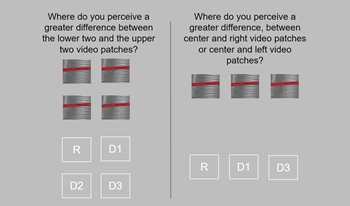
Different subjective methodologies exist to collect data on human perception of distortions, from rating methodologies with single or double stimuli to ranking with pairwise comparisons. The Maximum Likelihood Difference Scaling (MLDS) method uses triplet/quadruplet-based comparisons as a ranking task. Participants compare intervals inside pairs of stimuli: (a,b) and (c,d). The task is to rank if they perceive greater differences between (a,b) or (c,d). From these comparisons judgments, we can place the assessed stimuli on a perceptual scale (e.g., from low to high quality) with the help of a mathematical solver. However, one limitation is that the perceptual scales retrieved from stimuli of multiple contents are usually different. We previously offered a solution to measure the inter-content scale of multiple contents. In this work, we compare multiple rating and ranking methodologies. We examine obtained subjective quality scores regarding precision by analyzing discriminability in the scores, efficiency by comparing fixed experimental effort costs, and robustness of retrieve estimates to outliers and spammer behaviors. In this work, we put data quality, experimental cost, and resolving power into relation. We show how discriminability in the data impacts the resolving power of popular objective quality metrics. Our findings are that higher-performing metrics require higher-quality data to reveal their full potential.

Volumetric video is becoming easier to capture and display with the recent technical developments in the acquisition, and display technologies. Using point clouds is a popular way to represent volumetric video for augmented or virtual reality applications. This representation, however, requires a large number of points to achieve a high quality of experience and needs compression before storage and transmission. In this paper, we study the subjective and objective quality assessment results for volumetric video compression, using a state-of-the-art compression algorithm: MPEG Point Cloud Compression Test Model Category 2 (TMC2). We conduct subjective experiments to find the perceptual impacts on compressed volumetric video with different quantization parameters and point counts. Additionally, we find the relationship between the state-of-the-art objective quality metrics and the acquired subjective quality assessment results. To the best of our knowledge, this study is the first to consider TMC2 compression for volumetric video represented as coloured point clouds and study its effects on the perceived quality. The results show that the effect of input point counts for TMC2 compression is not meaningful, and some geometry distortion metrics disagree with the perceived quality. The developed database is publicly available to promote the study of volumetric video compression.